Role of Surface Energy Exchange for Simulating Wind Turbine Inflow: A Case Study in the Southern Great Plains, USA
Abstract
:1. Introduction
- (1)
- Is there a correlation between surface energy exchange and wind shear in the observations at this site? Is this correlation seasonal?
- (2)
- Is modeled energy flux and wind shear accuracy related to complexity in the LSM’s parameterization of soil–vegetation–atmosphere feedbacks?
2. Methods
2.1. Site Description and Instrumentation

2.2. Case Studies
| Variable of Interest | Case 1 | Case 2 | Case 3 |
|---|---|---|---|
| Date | 10–24 June 2011 | 13–27 July 2011 | 23 November–7 December 2012 |
| Climate characteristics | very warm, wet | hot, dry | cool, dry |
| Mean air temperature | 27.2 °C | 32.1 °C | 10.2 °C |
| Precipitation, including the two weeks prior | 55.8 mm | 8.8 mm | 18.1 mm |
| Mean root-zone soil moisture | 24% | 6% | 12% |
| Crop | canola | none | none |
| Field conditions | peak LAI and active canopy in early June then rapid senescence | post-harvest, bare soil with small amounts of crop residue | bare soil with small amounts of crop residue and emerging wheat seedlings |
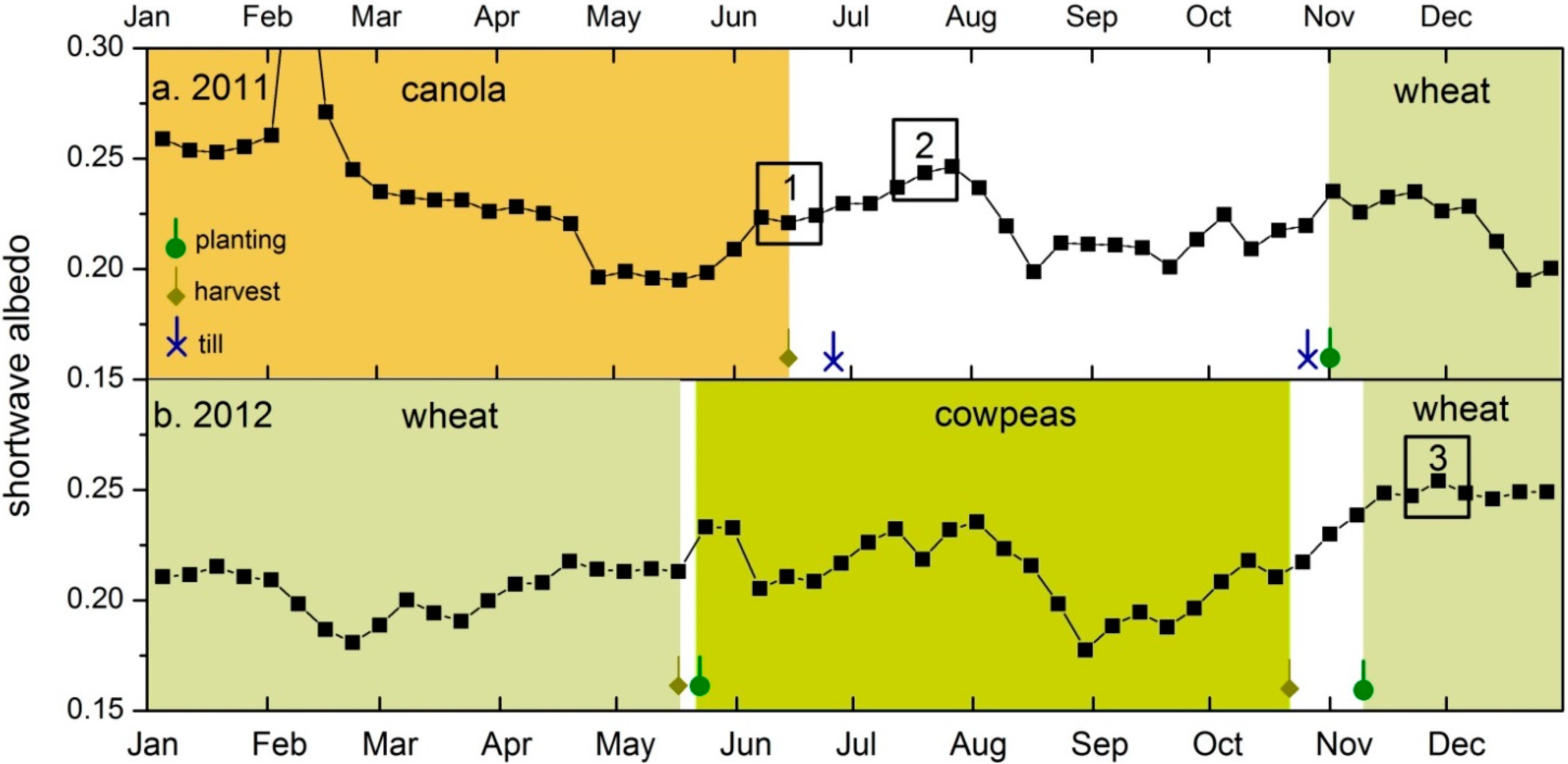
2.3. WRF Domain Configuration
2.4. Ensemble Description

2.5. Input Data
2.6. Four-Dimensional Data Assimilation
2.7. Land Surface Models
| LSM | Vegetation | Drivers of Soil Moisture | Soil Layers | Drivers of Water Flux Exchange |
|---|---|---|---|---|
| Thermal diffusion | None | LUC | 5 | Soil surface |
| RUC | Extension of soil | LUC + evap | 6 or 9; 3 m max | Air temperature, relative humidity |
| Pleim-Xiu (PX) | 1-layer from LUC | LUC+ evap+ roots | 2; 1 m max | Soil surface + plant transpiration |
| Noah | 1-layer from LUC | LUC+ evap+ roots+ drainage | 4; 2 m max | Soil surface + plant transpiration |
| Noah-MP 1—Ball-Berry/TOPMODEL | 2-layer from multiple LUC | LUC + evap + roots + drainage + runoff + storage | Variable; 8 m max | Complex soil–plant feedbacks |
| Noah-MP 2—Ball-Berry/BATS | 2-layer from multiple LUC | LUC + evap + roots + drainage + runoff + storage | Variable; 8 m max | Complex soil–plant feedbacks |
| Noah-MP 3—Jarvis/TOPMODEL | 2-layer from multiple LUC | LUC + evap + roots + drainage + runoff + storage | Variable; 8 m max | Complex soil–plant feedbacks |
| Noah-MP 4—Jarvis/BATS | 2-layer from multiple LUC | LUC + evap + roots + drainage + runoff + storage | Variable; 8 m max | Complex soil–plant feedbacks |
3. Results and Discussion
3.1. Land-Atmosphere Energy Exchange
3.1.1. Observations
3.1.2. LSM Performance
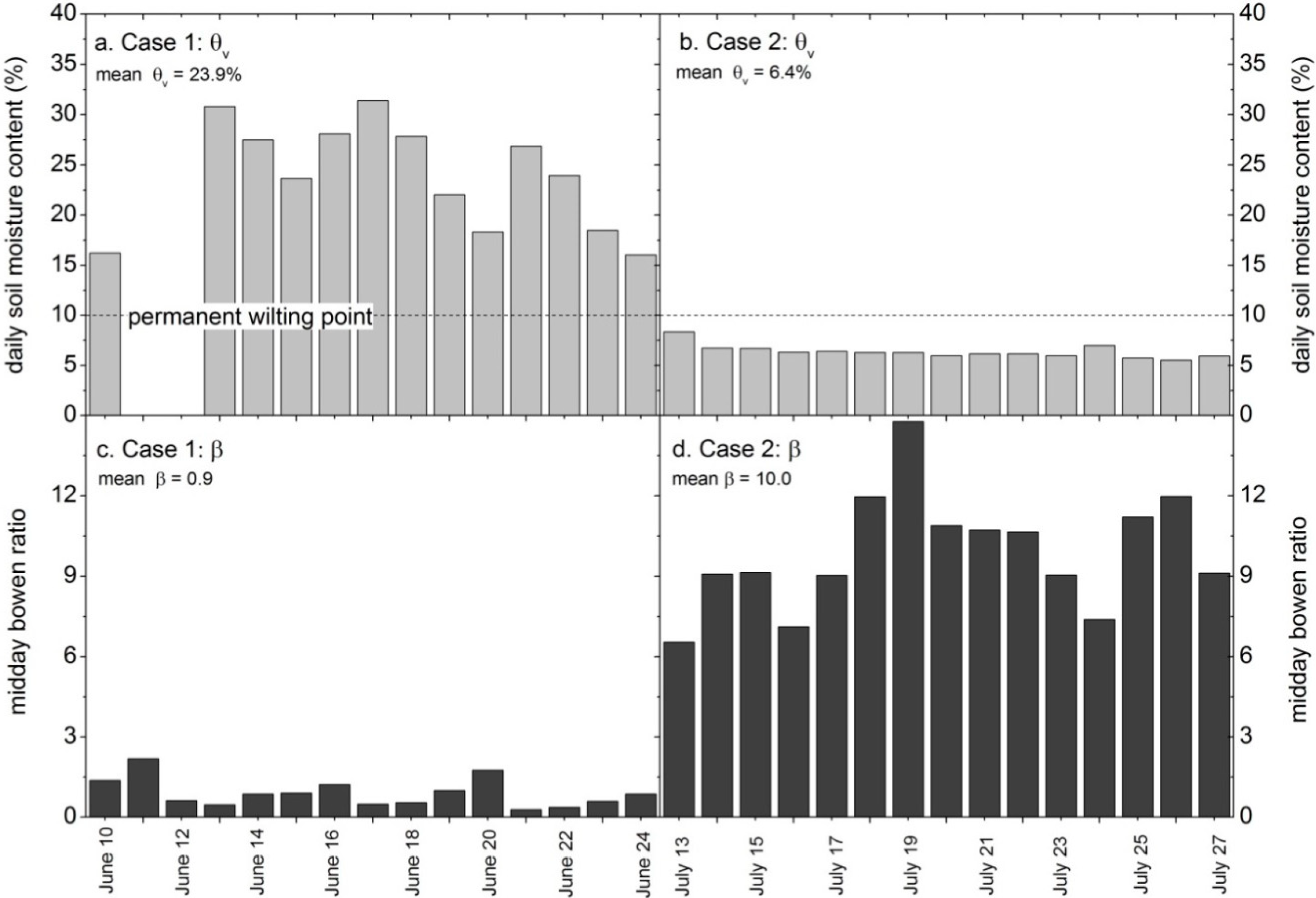
| Observations/LSM | Case 1 | Case 2 | Case 3 |
|---|---|---|---|
| Observations | 0.92 ± 0.62 | 9.90 ± 4.52 | 5.33 ± 2.30 |
| Thermal diffusion | 0.20 ± 0.12 | 0.23 ± 0.11 | 0.76 ± 0.27 |
| RUC | 4.43 ± 4.15 | 132.45 ± 237.36 | 2.47 ± 2.43 |
| PX | 1.12 ± 0.36 | 1.36 ± 1.02 | 1.29 ± 0.53 |
| Noah | 1.82 ± 0.26 | 4.40 ± 0.82 | 2.54 ± 1.58 |
| Noah-MP 1 | 1.55 ± 0.27 | 5.89 ± 2.37 | 9.01 ± 3.91 |
| Noah-MP 2 | 2.05 ± 0.38 | 5.47 ± 2.61 | 8.64 ± 3.98 |
| Noah-MP 3 | 1.97 ± 0.39 | 7.55 ± 3.34 | 8.34 ± 3.84 |
| Noah-MP 4 | 1.12 ± 0.38 | 7.41 ± 2.92 | 8.41 ± 3.86 |
| LSM Range | 0.20–4.43 | 0.23–132.45 | 0.76–9.01 |
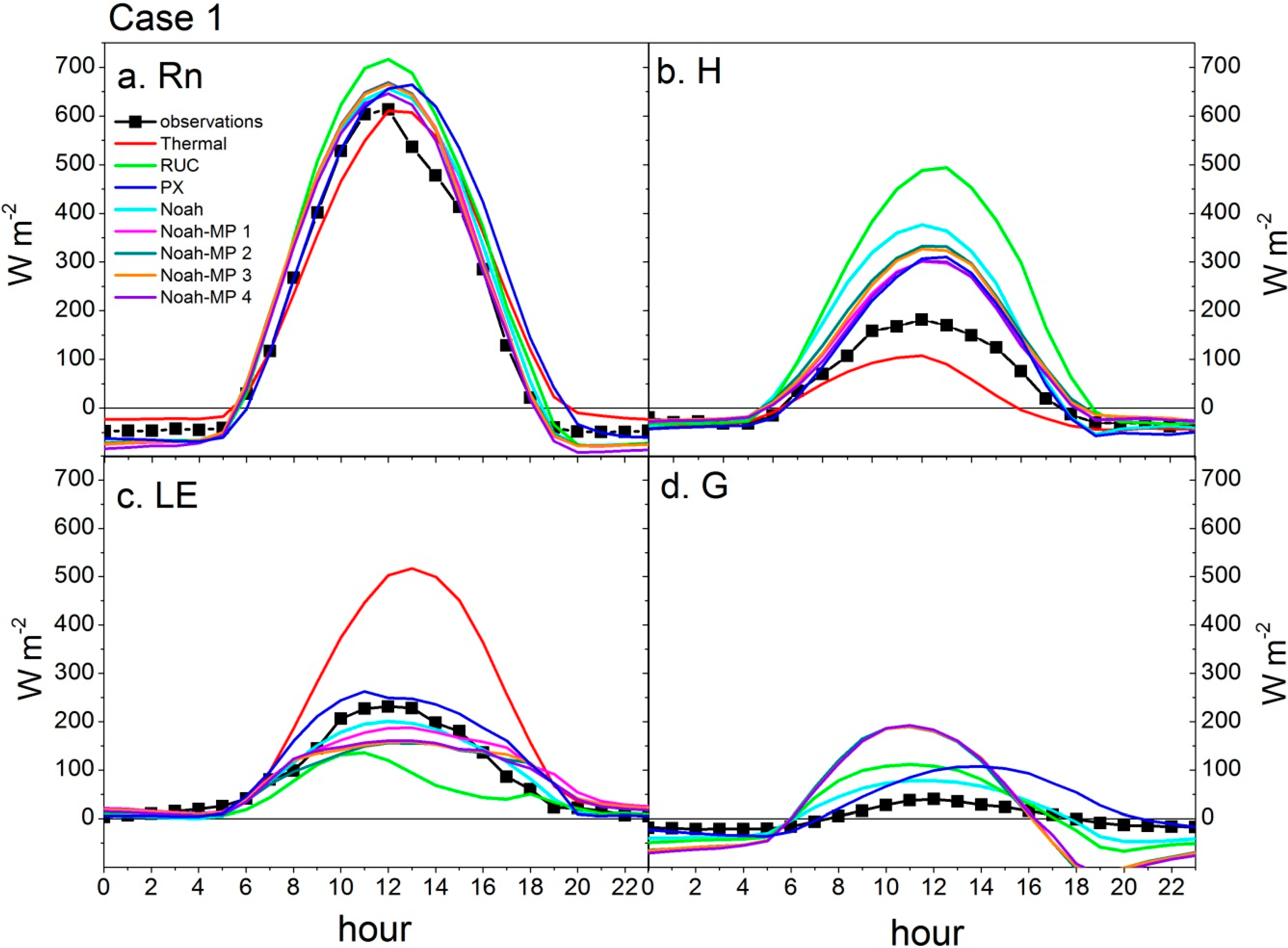
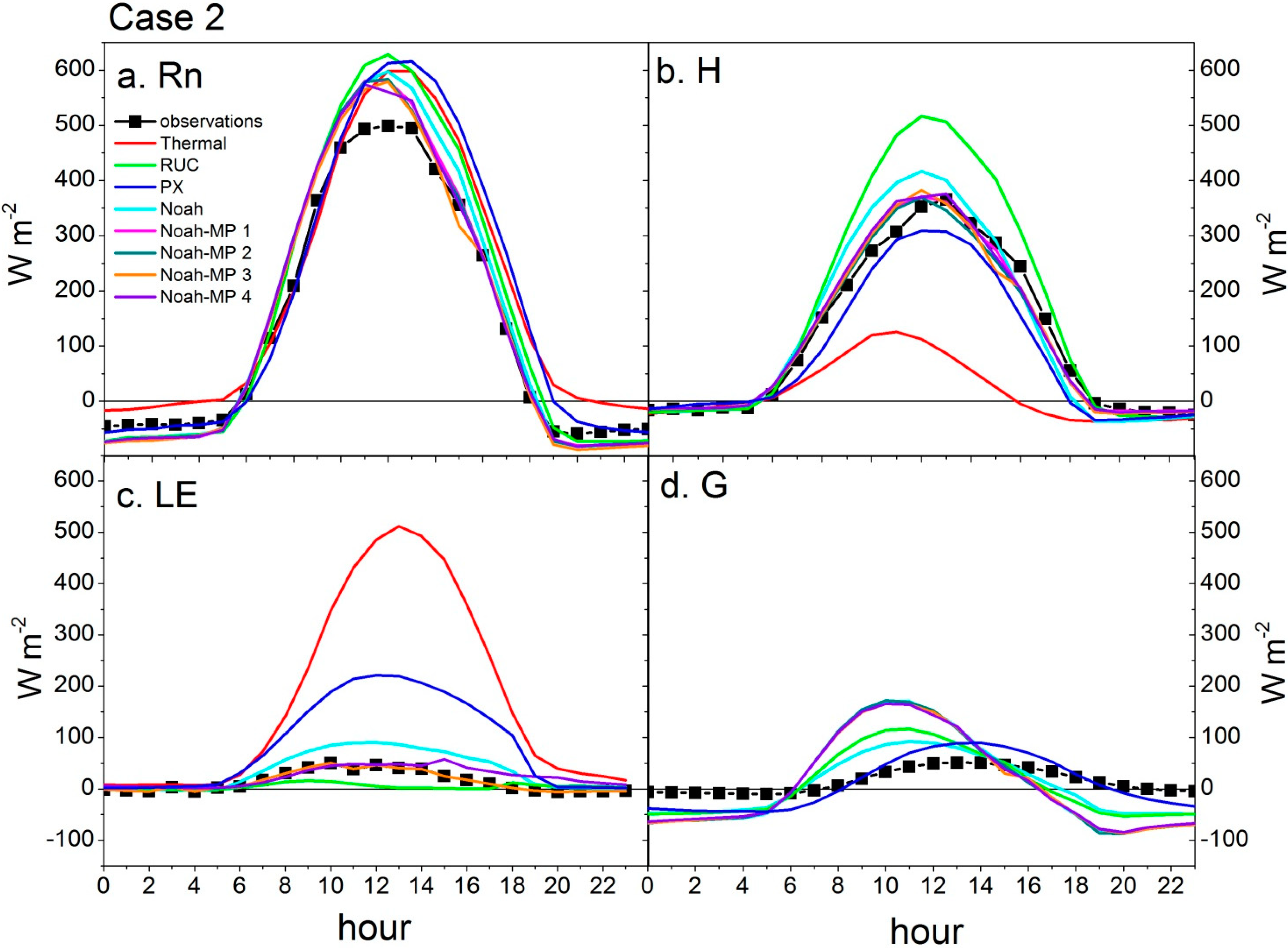
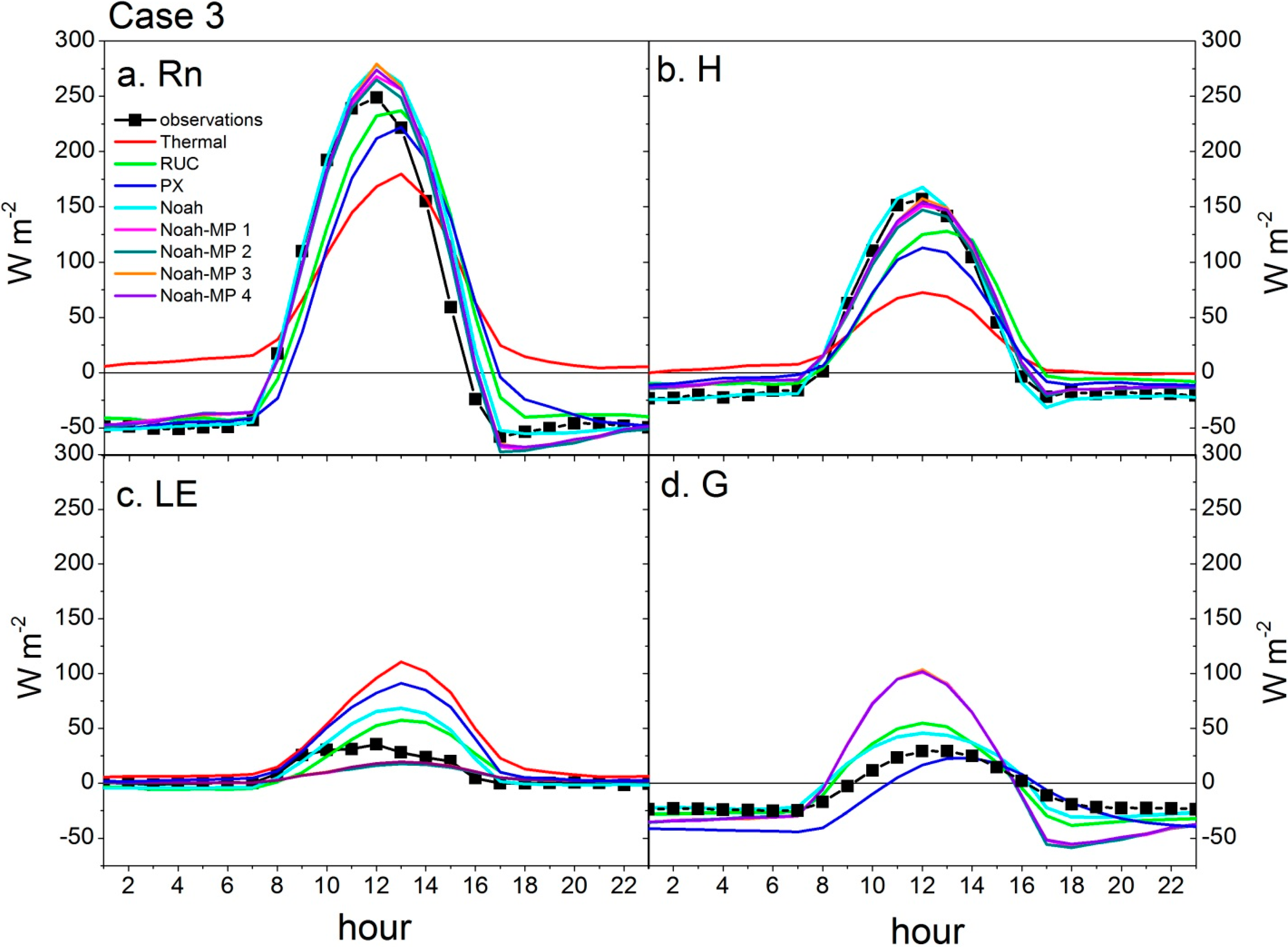
3.2. Rotor-Disk Wind Shear
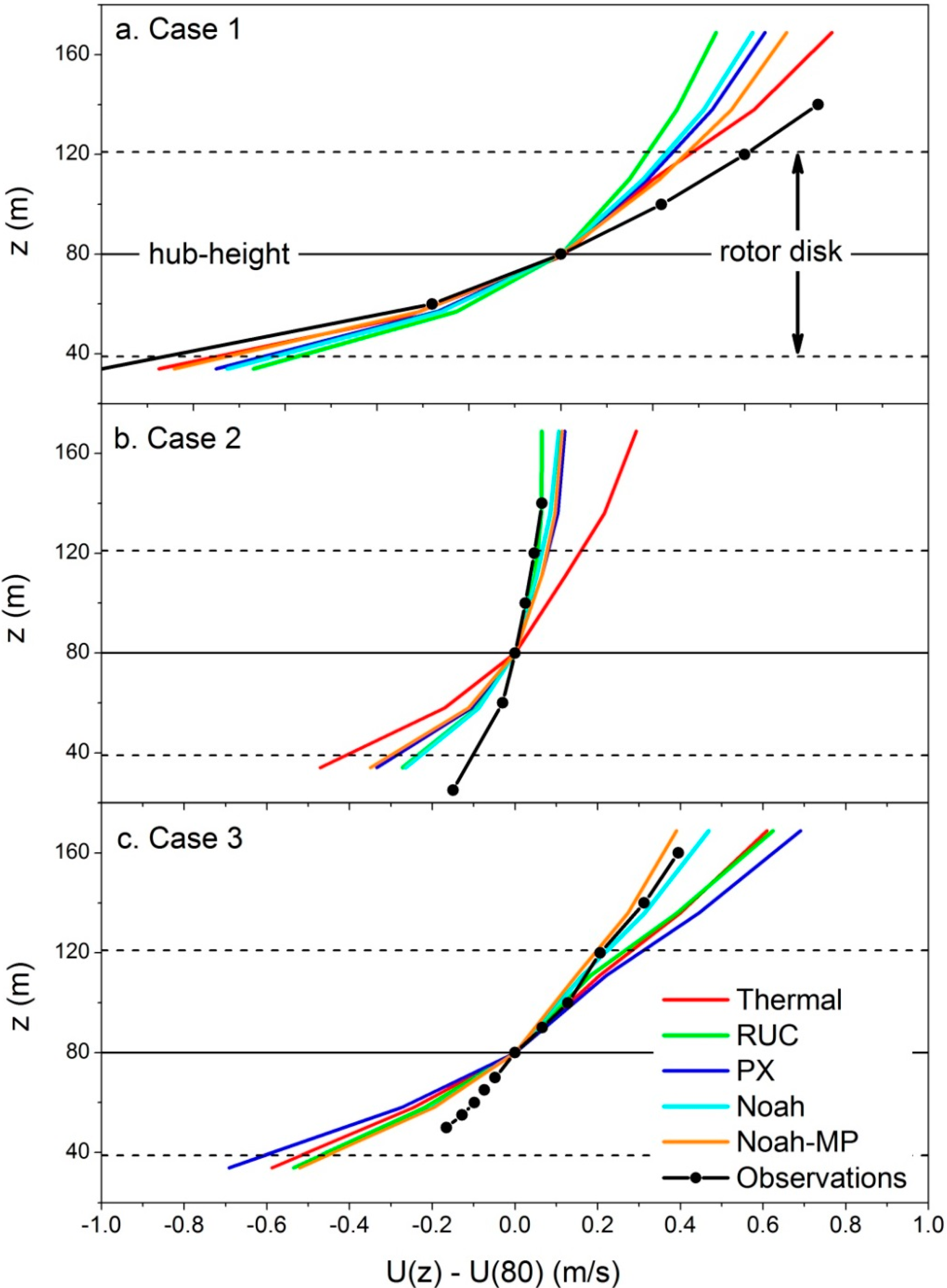
3.3. Relationship between Wind Shear and Surface Energy Exchange
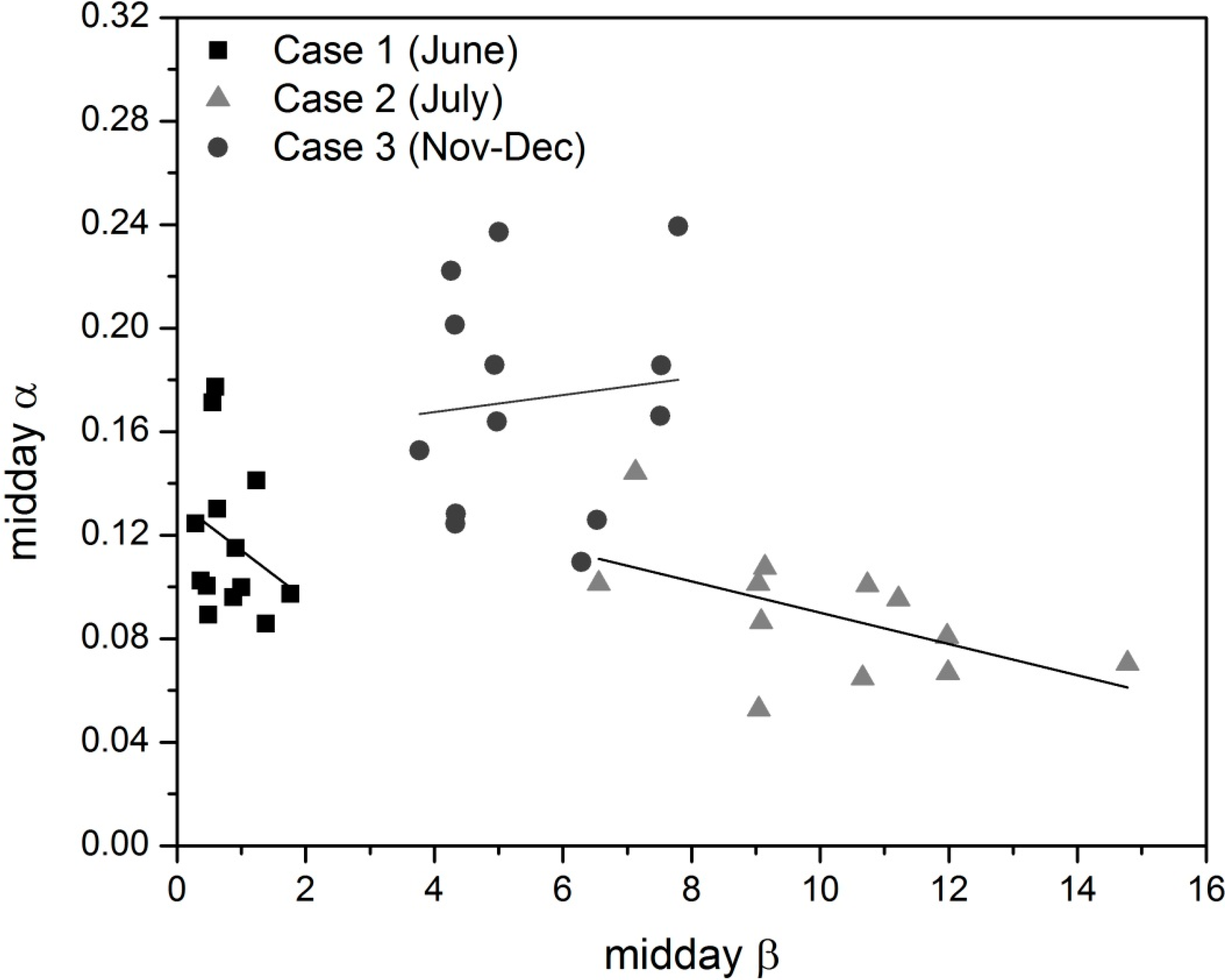
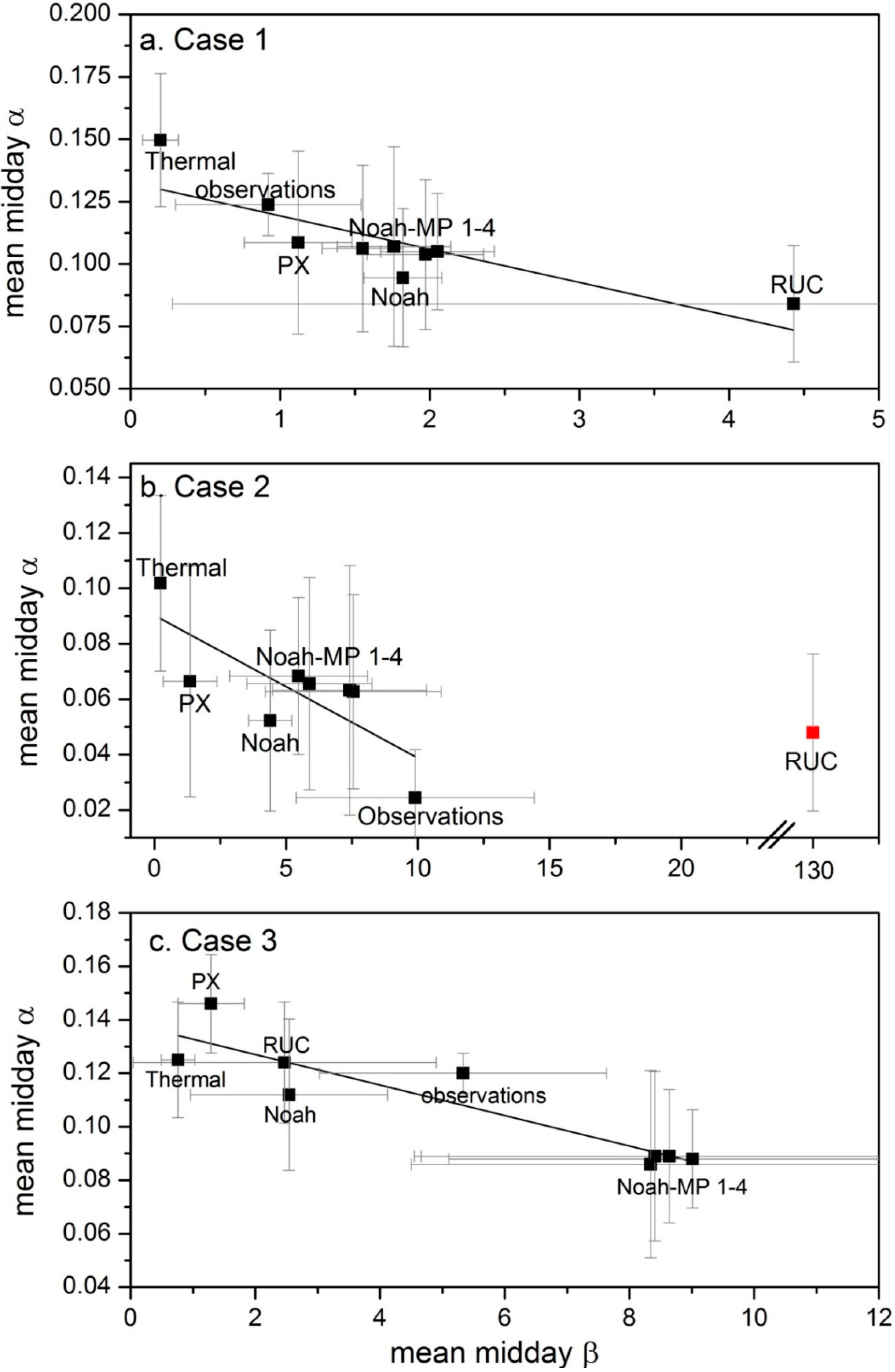
4. Conclusions
Acknowledgments
Author Contributions
Conflicts of Interest
References
- Lew, D.; Milligan, M.; Jordan, G.; Piwko, R. Value of Wind Power Forecasting; NREL Report No. CP-5500–50814; NREL: Golden, CO, USA, 2011. [Google Scholar]
- Skamarock, W.C.; Klemp, J.B.; Dudhia, J.; Gill, D.O.; Barker, D.M.; Duda, M.; Huang, X.-Y.; Wang, W.; Powers, J.G. A Description of the Advanced Research WRF Version 3. NCAR Technical Report 2008. Available online: http://www.mmm.ucar.edu/wrf/users/docs/arw_v3.pdf (accessed on 2 February 2014).
- American Wind Energy Association. Oklahoma Wind Energy Fact Sheet April 2014. Available online: http://awea.files.cms-plus.com/images/oklahoma.pdf (accessed on 21 May 2014).
- Wiser, R.; Bolinger, M.; Barbose, G.; Darghouth, N.; Hoen, B.; Mills, A.; Weaver, S.; Porter, K.; Buckley, M.; Fink, S.; Oteri, F.; Tegen, S. 2012 Wind Technologies Market Report; DOE/GO-102013–3948; U.S. Department of Energy, Office of Energy Efficiency and Renewable Energy: Washington, DC, USA, 2013. [Google Scholar]
- Chen, F.; Bornstein, R.; Grimmond, S.; Li, J.; Liang, X.; Martilli, A.; Miao, S.; Voogt, J.; Wang, Y. Research priorities in observing and modeling urban weather and climate. Bull. Am. Meteorol. Soc. 2012, 93, 1725–1728. [Google Scholar] [CrossRef]
- Anderson, D.E.; Verma, S.B. Carbon-dioxide, water-vapor and sensible heat exchanges of a grain-sorghum canopy. Bound. Layer Meteor. 1986, 34, 317–331. [Google Scholar] [CrossRef]
- Baldocchi, D.D. A comparative study of mass and energy exchange rates over a closed C-3 (wheat) and an open C-4 (corn) crop. Part 2: CO2 exchange and water use efficiency. Agric. For. Meteorol. 1994, 67, 291–321. [Google Scholar] [CrossRef]
- Betts, A.K.; Ball, J.H.; Beljaars, A.C.M.; Miller, M.J.; Viterbo, P.A. The land surface-atmosphere interaction: A review based on observational and global model perspectives. J. Geophys. Res. 1996, 101, 7209–7225. [Google Scholar] [CrossRef]
- Raupach, M.R. Equilibrium evaporation and the convective boundary layer. Bound. Layer Meteor. 2000, 96, 107–141. [Google Scholar] [CrossRef]
- Patton, E.G.; Sullivan, P.P.; Moeng, C.-H. The influence of idealized heterogeneity on wet and dry planetary boundary layers coupled to the land surface. J. Atmos. Sci. 2004, 62, 2078–2097. [Google Scholar] [CrossRef]
- Desai, A.R.; Davis, K.J.; Senff, C.J.; Ismail, S.; Browell, E.V.; Stauffer, D.R.; Reen, B.P. A case study of the effects of heterogeneous soil moisture on mesoscale boundary-layer structure in the Southern Great Plains, U.S.A. Part 1: Simple prognostic model. Bound. Layer Meteorol. 2006, 119, 195–238. [Google Scholar] [CrossRef]
- Maxwell, R.M.; Chow, F.K.; Kollet, S.J. The groundwater-land surface-atmosphere connection: Soil moisture effects on the atmospheric boundary layer in fully-coupled simulations. Adv. Water Resourc. 2007, 30, 2447–2466. [Google Scholar] [CrossRef]
- Fischer, M.L.; Billesbach, D.P.; Riley, W.J.; Berry, J.A.; Torn, M.S. Spatiotemporal variations in growing season exchanges of CO2, H2O, and sensible heat in agricultural fields of the Southern Great Plains. Earth Interact. 2007, 11, 1–21. [Google Scholar] [CrossRef]
- Storm, B.; Basu, S. The WRF model forecast-derived low-level wind shear climatology over the United States Great Plains. Energies 2010, 3, 258–276. [Google Scholar] [CrossRef]
- Draxl, C.; Hahmann, A.N.; Peña, A.; Giebel, G. Evaluating winds and vertical wind shear from Weather Research and Forecasting model forecasts using seven planetary boundary layer schemes. Wind Energy 2014, 17, 39–55. [Google Scholar] [CrossRef]
- Vanderwende, B.J.; Lundquist, J.K. Could crop height impact the wind resource at agriculturally productive wind farms? In Proceedings of the 21st Symposium on Boundary Layers and Turbulence, Leeds, UK, 9–13 June 2014.
- Rohatgi, J.; Barbezier, G. Wind turbulence and atmospheric stability—Their effects on wind turbine output. Renew. Energy 1999, 16, 908–911. [Google Scholar] [CrossRef]
- Sumner, J.; Masson, C. Influence of atmospheric stability on wind turbine power performance curves. J. Sol. Energy Eng. 2006, 128, 531–537. [Google Scholar] [CrossRef]
- Van den Berg, G.P. Wind turbine power and sound in relation to atmospheric stability. Wind Energy 2008, 11, 151–169. [Google Scholar] [CrossRef]
- Wagner, R.; Antoniou, I.; Pedersen, S.M.; Courtney, M.S.; Jørgensen, H.E. The influence of the wind speed profile on wind turbine performance measurements. Wind Energy 2009, 12, 348–362. [Google Scholar] [CrossRef]
- Vanderwende, B.J.; Lundquist, J.K. The modification of wind turbine performance by statistically distinct atmospheric regimes. Environ. Res. Lett. 2012. [Google Scholar] [CrossRef]
- Wharton, S.; Lundquist, J.K. Assessing atmospheric stability and its impact on rotor disk wind characteristics at an onshore wind farm. Wind Energy 2012, 15, 525–546. [Google Scholar] [CrossRef]
- Wharton, S.; Lundquist, J.K. Atmospheric stability affects wind turbine power collection. Environ. Res. Lett. 2012. [Google Scholar] [CrossRef]
- Trier, S.B.; Davis, C.A.; Ahijevych, D. Environmental controls on the simulated diurnal cycle of warm-season precipitation in the Continental United States. J Atmos. Sci. 2010. [Google Scholar] [CrossRef]
- LeMone, M.A.; Grossman, R.L.; Coulter, R.L.; Wesley, M.L.; Klazura, G.E.; Poulos, G.S.; Blumen, W.; Lundquist, J.K.; Cuenca, R.H.; Kelly, S.F.; et al. Land–atmosphere interaction research and opportunities in the Walnut River watershed in Southeast Kansas: CASES and ABLE. Bull. Am. Meteorol. Soc. 2000, 81, 757–779. [Google Scholar]
- Weckwerth, T.; Parsons, D.B.; Koch, S.E.; Moore, J.A.; LeMone, M.A.; Demoz, B.B.; Flamant, C.; Geerts, B.; Wang, J.; Feltz, W.F. An overview of the International H2O Project (IHOP_2002) and some preliminary highlights. Bull. Am. Meteorol. Soc. 2004, 85, 253–277. [Google Scholar] [CrossRef]
- LeMone, M.A.; Chen, F.; Alfieri, J.G.; Tewari, M.; Geerts, B.; Miao, Q.; Grossman, R.L.; Coulter, R.L. Influence of land cover and soil moisture on the horizontal distribution of sensible and latent heat fluxes in Southeast Kansas during IHOP_2 and CASES-97. J. Hydrometeorol. 2007, 8, 68–87. [Google Scholar] [CrossRef]
- Miller, J.; Barlage, M.; Zeng, X.; Wei, H.; Mitchell, K.; Tarpley, D. Sensitivity of the NCEP/Noah land surface model to the MODIS green vegetation fraction data set. Geophys. Res. Lett. 2006. [Google Scholar] [CrossRef]
- Case, J.L.; LaFontaine, F.J.; Kumar, S.V.; Peters-Lidard, C.D. Using the NASA-Unified WRF to assess the impacts of real-time vegetation on simulations of severe weather. In Proceedings of the 13th Annual WRF User’s Workshop, Boulder, CO, USA, 26–29 June 2012; pp. 1–69.
- Torn, M.S.; Biraud, S.C.; Still, C.J.; Riley, W.J.; Berry, J.A. Seasonal and interannual variability in 13C composition of ecosystem carbon fluxes in the U.S. Southern Great Plains. Tellus 2011, 63B, 181–195. [Google Scholar] [CrossRef]
- Billesbach, D.P.; Fischer, M.L.; Torn, M.S.; Berry, J.A. A portable eddy covariance system for the measurement of ecosystem-atmosphere exchange of CO2, water vapor, and energy. J Atmos. Ocean. Technol. 2004, 21, 639–650. [Google Scholar] [CrossRef]
- Riley, W.J.; Biraud, S.C.; Torn, M.S.; Fischer, M.L.; Billesbach, D.P.; Berry, J.A. Regional CO2 and latent heat surface fluxes in the Southern Great Plains: Measurements, modeling, and scaling. J. Geophys. Res. 2009. [Google Scholar] [CrossRef]
- Raz-Yaseef, N.; Fischer, M.L.; Billesbach, D.P.; Biraud, S.C.; Gunter, S.A.; Bradford, J.A.; Torn, M.S. Drought sensitivity of three U.S. southern plains ecosystems. Environ. Res. Lett. submitted.
- Finkelstein, P.L.; Sims, P.F. Sampling error in eddy correlation flux measurements. J. Geophys. Res. 2001, 106, 3503–3509. [Google Scholar] [CrossRef]
- Obukhov, A.M. Turbulence in an atmosphere with a non-uniform temperature. Bound. Layer Meteorol. 1971, 2, 7–29. [Google Scholar] [CrossRef]
- Webb, E.K.; Pearman, G.I.; Leuning, R. Correction of flux measurements for density effects due to heat and water vapour transfer. Quart. J. Roy. Meteorol. Soc. 1980, 106, 85–100. [Google Scholar] [CrossRef]
- Moore, C.J. Frequency response corrections for eddy correlation systems. Bound. Layer Meteorol. 1986, 37, 17–35. [Google Scholar] [CrossRef]
- Wilson, K.; Goldstein, A.; Falge, E.; Aubinet, M.; Baldocchi, D.; Berbigier, P.; Bernhofer, C.; Ceulemans, R.; Dolman, H.; Field, C.; et al. Energy balance closure at FLUXNET sites. Agric. For. Meteorol. 2002, 113, 223–243. [Google Scholar]
- Newsom, R.K. Doppler Lidar Handbook. Office of Biological and Environmental Research, Office of Science, U.S. Department of Energy: Washington, DC, USA. Available online: http://www.arm.gov/publications/tech_reports/handbooks/dl_handbook.pdf (accessed on 15 December 2014).
- Emeis, S. Measurement Methods in Atmospheric Sciences: In-Situ and Remote; Borntraeger Science Publishers: Stuttgart, Germany, 2010. [Google Scholar]
- Betancur, S.; Lemoine, R.; Boinne, R.; Mail, P.-A.; Dewilde, L. Reducing risk in resource assessment using lidar. In Proceedings of the WindExpo Conference, Guadalajara, Mexico, 5–7 November 2008.
- Cañadillas, B.; Westerhellweg, A.; Neumann, T. Testing the performance of a ground-based wind LiDAR system: One year intercomparison at the offshore platform FINO1. Dewi Mag. 2011, 38, 58–64. [Google Scholar]
- Blackadar, A.K. Modeling pollutant transfer during daytime convection. In Proceedings of the Fourth Symposium on Atmospheric Turbulence, Diffusion and Air Quality, Reno, NV, USA, 15–18 January 1979; pp. 443–447.
- Smirnova, T.G.; Brown, J.M.; Benjamin, S.G. Performance of different soil model configurations in simulating ground surface temperature and surface fluxes. Mon. Weather Rev. 1997, 125, 1870–1884. [Google Scholar] [CrossRef]
- Pleim, J.E.; Xiu, A. Development and testing of a surface flux and planetary boundary layer model for application in mesoscale models. J. Appl. Meteor. 1995, 34, 16–32. [Google Scholar] [CrossRef]
- Xiu, A.; Pleim, J.E. Development of a land surface model. Part I: Application in a mesoscale meteorological model. J. Appl. Meteor. 2001, 40, 192–209. [Google Scholar] [CrossRef]
- Chen, F.; Mitchell, K.; Schaake, J.; Xue, Y.; Pan, H.-L.; Koren, V.; Duan, Q.Y.; Ek, M.; Betts, A. Modeling of land surface evaporation by four schemes and comparison with FIFE observations. J. Geophys. Res. 1996, 101, 7251–7268. [Google Scholar] [CrossRef]
- Niu, G.-Y.; Yang, Z.-L.; Mitchell, K.E.; Chen, F.; Ek, M.B.; Barlage, M.; Kumar, A.; Manning, K.; Niyogi, D.; Rosero, E.; et al. The community Noah land surface model with multiparameterization options (Noah-MP): 1. Model description and evaluation with local-scale measurements. J. Geophys. Res. 2011. [Google Scholar] [CrossRef]
- Stauffer, D.R.; Seaman, N.L. On multi-scale four-dimensional data assimilation. J. Appl. Meteor. 1994, 33, 416–434. [Google Scholar] [CrossRef]
- Liu, Y.; Bourgeois, A.; Warner, T.; Swerdlin, S.; Hacker, J. An implementation of obs-nudging-based FDDA into WRF for supporting ATEC test operations. In Proceedings of the WRF User Workshop, Boulder, CO, USA, 27–30 June 2005. Paper 10.7.
- Stauffer, D.R.; Seaman, N.L. Use of four-dimensional data assimilation in a limited-area mesoscale model. Part I: Experiments with synoptic-scale data. Mon. Weather Rev. 1990, 118, 1250–1277. [Google Scholar] [CrossRef]
- Lo, J.C.F.; Yang, Z.L.; Pielke, R.A., Sr. Assessment of three dynamical climate downscaling methods using the Weather Research and Forecasting (WRF) model. J. Geophys. Res. 2008. [Google Scholar] [CrossRef]
- Otte, T.L. The impact of nudging in the meteorological model for retrospective air quality simulations. Part I: Evaluation against national observation networks. J. Appl. Meteorol. Climatol. 2008, 47, 1853–1867. [Google Scholar] [CrossRef]
- Salathé, E.P.; Steed, R.; Mass, C.F.; Zahn, P.H. A high-resolution climate model for the U.S. Pacific Northwest: Mesoscale feedbacks and local responses to climate change. J. Clim. 2008, 21, 5708–5726. [Google Scholar] [CrossRef]
- Bowden, J.H.; Otte, T.L.; Nolte, C.G.; Otte, M.J. Examining interior grid nudging techniques using two-way nesting in the WRF model for regional climate modeling. J. Clim. 2012, 25, 2805–2823. [Google Scholar] [CrossRef]
- Pan, H.-L.; Mahrt, L. Interaction between soil hydrology and boundary layer development. Bound. Layer Meteorol. 1987, 38, 185–202. [Google Scholar] [CrossRef]
- Noilhan, J.; Planton, S. A simple parameterization of land surface processes for meteorological models. Mon. Weather Rev. 1989, 117, 536–549. [Google Scholar]
- Xia, Y.; Mitchell, K.; Ek, M.; Sheffield, J.; Cosgrove, B.; Wood, E.; Luo, L.; Alonge, C.; Wei, H.; Meng, J.; et al. Continental-scale water and energy flux analysis and validation for the North American Land Data Assimilation System project phase 2(NLDAS-2): 1. Intercomparison and application of model products. J. Geophys. Res. 2012. [Google Scholar] [CrossRef]
- Yang, Z.L.; Dickinson, R.E. Description of the Biosphere-Atmosphere Transfer Scheme (BATS) for the Soil Moisture Workshop and evaluation of its performance. Glob. Planet. Chang. 1996, 13, 117–134. [Google Scholar] [CrossRef]
- Niu, G.-Y.; Yang, Z.-L.; Dickinson, R.E.; Gulden, L.E. A simple TOPMODEL-based runoff parameterization (SIMTOP) for use in global climate models. J. Geophys. Res. 2005. [Google Scholar] [CrossRef]
- Cai, X.; Yang, Z.-L.; David, C.H.; Niu, G.-Y.; Rodell, M. Hydrological evaluation of the Noah-MP land surface model for the Mississippi River basin. J. Geophys. Res. 2014. [Google Scholar] [CrossRef]
- Blyth, E.; Gash, J.; Lloyd, A.; Pryor, M.; Weedon, G.P.; Shuttleworth, J. Evaluating the JULES land surface model energy fluxes using FLUXNET data. J. Hydrometeorol. 2010, 11, 509–519. [Google Scholar] [CrossRef]
- Gaylor, S.; Wohling, T.; Grzeschik, M.; Ingwersen, J.; Wizemann, H.D.; Warrach-Sagi, K.; Hogy, P.; Attinger, S.; Streck, T.; Wulfmeyer, R. Incorporating dynamic root growth enhances the performance of Noah-MP at two contrasting winter wheat field sites. Water Resourc. Res. 2014, 50, 1337–1356. [Google Scholar] [CrossRef]
- Van Wijk, A.J.M.; Beljaars, A.C.M.; Holtslag, A.A.M.; Turkenburg, W.C. Evaluation of stability corrections in wind speed profiles over the North Sea. J. Wind Eng. Ind. Aerodyn. 1990, 33, 551–566. [Google Scholar] [CrossRef]
- Elliott, D.L.; Cadogan, J.B. Effects of wind shear and turbulence on wind turbine power curves. In Proceedings of the European Community Wind Energy Conference and Exhibition, Madrid, Spain, 10–14 September 1990.
- Kelley, N.; Shirazi, M.; Jager, D.; Wilde, S.; Adams, J.; Buhl, M.; Sullivan, P.; Patton, E. Lamar Low-Level Jet Project Interim Report; NREL/TP-500–34593; NREL: Golden, CO, USA, 2004; pp. 1–216. [Google Scholar]
- Department of Energy, Energy Efficiency and Renewable Energy. Wind Program Complex Flow Workshop Report; Department of Energy, Energy Efficiency and Renewable Energy: Boulder, CO, USA, 2012; pp. 1–122. [Google Scholar]
© 2014 by the authors; licensee MDPI, Basel, Switzerland. This article is an open access article distributed under the terms and conditions of the Creative Commons Attribution license (http://creativecommons.org/licenses/by/4.0/).
Share and Cite
Wharton, S.; Simpson, M.; Osuna, J.L.; Newman, J.F.; Biraud, S.C. Role of Surface Energy Exchange for Simulating Wind Turbine Inflow: A Case Study in the Southern Great Plains, USA. Atmosphere 2015, 6, 21-49. https://doi.org/10.3390/atmos6010021
Wharton S, Simpson M, Osuna JL, Newman JF, Biraud SC. Role of Surface Energy Exchange for Simulating Wind Turbine Inflow: A Case Study in the Southern Great Plains, USA. Atmosphere. 2015; 6(1):21-49. https://doi.org/10.3390/atmos6010021
Chicago/Turabian StyleWharton, Sonia, Matthew Simpson, Jessica L. Osuna, Jennifer F. Newman, and Sebastien C. Biraud. 2015. "Role of Surface Energy Exchange for Simulating Wind Turbine Inflow: A Case Study in the Southern Great Plains, USA" Atmosphere 6, no. 1: 21-49. https://doi.org/10.3390/atmos6010021
APA StyleWharton, S., Simpson, M., Osuna, J. L., Newman, J. F., & Biraud, S. C. (2015). Role of Surface Energy Exchange for Simulating Wind Turbine Inflow: A Case Study in the Southern Great Plains, USA. Atmosphere, 6(1), 21-49. https://doi.org/10.3390/atmos6010021







